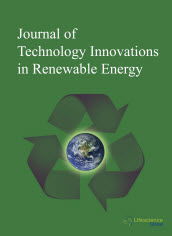jtire
|
|
|
Abstract: This paper presents a description of the mathematical model developed to predict the natural frequency of a particular refrigerant or refrigerant mixture and magnetic field frequency using the one-dimensional fluid flow conservation equations. The results show the dependence of the Nusselt number on the Reynolds number in the presence and absence of magnetic field. However, the results also provide evidence of enhanced heat transfer and heat flux under magnetic field compared to without magnetic field. In addition, the results presented in the paper clearly provide evidence that the heat transmission has been consistently enhanced when magnetic field is applied. It also appears that heat transfer enhancement is greater at higher Nusselt numbers. Keywords: Magnetic field, heat transfer, enhancement, refrigerant mixtures.Download Full Article |
|
|
|
Abstract: During the period up to 2040, renewable energy sources (RES) will have the highest growth rates of all forms of energy. Based on the calculations on the world energy model incorporated in the SCANER modelling and information complex (working on the basis of optimization, econometric analysis, and balance approach), key trends in the world consumption of renewable energy sources; the share of OECD and non-OECD countries in the use of the renewable energy sources; consumption of renewable energy sources by type; end use and the impact on the electricity sector during the period up to 2040 were observed. The main finding of the paper is that RES are becoming more competitive and therefore will be used on an increasingly wide scale not only in the OECD countries, but also in the whole world. At the same time, due to the fact that RES start their take-off from a modest basis, they will only have a limited influence on the shares of hydrocarbons in the energy mix. Keywords: Renewable energy sources, energy system, energy markets, optimization model, balance approach.Download Full Article |
|
|
|
Abstract: The improvement of renewable energy sources exploitation is a central topic of the present studies in the energetic field. One of the main obstacles to the renewable energy increase in the global energetic mix is represented by the fluctuating nature of renewable power sources. The power fluctuations are cause of stress for the electric grid to which the individual nodes are connected. A wider exploitation of renewable power is possible through the implementation of a “smart grid”, constituted by an interconnection of several smart nodes consisting in a user and a renewable source. To reduce the stochastic effects of the renewable energy source it is possible to introduce in the nodes composing the smart grid an energy storage, finalized to smooth the power peaks, rending the node itself less disturbing for the electric grid. This paper presents a simulation model of a smart node, consisting in a user power profile, a photovoltaic panel, an electric vehicle and a battery. Through the simulation model it is possible to evaluate the node effect on the electric grid, with a quantitative approach. Tests were worked out in different node configurations: basic (the only user power profile), basic with photovoltaic panel, basic with storage, basic with panel and storage and finally the complete configuration including also the electric vehicle. The tests were repeated for a domestic and an industrial user to evaluate the size influence over the parameters of interest. Keywords: Smart grid, electrochemical storage, renewable energy, dynamic simulation, Matlab-Simulink.Download Full Article |
|
|
|
Abstract: The paper presents a simulation study using the numerical simulator SCAPS-1D to model ZnO/Cd0.8Zn0.2S/CuIn(1-y)GaySe2/CuInSe2 structures. Effects of thickness of graded and ungraded CIGS absorbers and buffer layers on cell performance have been investigated with the aim to reach a higher efficiency. Quantum efficiency (QE) as function of wavelength and thickness of these layers was studied. The high efficiency of CIGS cells, in order of 22.05%, has reached with the absorbers thickness between 2μm and 3.5μm and with acceptor concentration of about 2.1016 cm3. Other hand, we investigate the effect of Cd0.8Zn0.2S ternary compound buffer on the top of the p-CIGS cell. These simulation results give some important indication to enable further development of multilayer thin-film solar cells based on CuInGaSe2 with Cd0.8Zn0.2S as buffer layer instead of CdS. Keywords: Photovoltaic parameters, CIGS solar cells, CdZnS, SCAPS-1D, Modeling.Download Full Article |
|
|
|
Abstract: One of the main degradation mechanisms which cause risks to safety and reliability of pressurized water nuclear reactors is the primary water stress corrosion cracking (PWSCC) in nickel alloys, such as Alloy 600 (75Ni-15Cr-9Fe), and its weld metal Alloy 182 (67 Ni-15Cr-8Fe). It can appear at several reactor nozzles dissimilarly welded with Alloys 182/82 between steel ASTM A-508 G3 and stainless steel AISI316L, among others. The hydrogen which is dissolved to primary water to prevent radiolysis, can also have influence on the stress corrosion cracking behavior.In this article one departs from a study of Lima based in experimental data obtained from CDTN-Brazilian Nuclear Technology Development Center, in slow strain rate test (SSRT). It was prepared and used for tests a weld in laboratory, similar to dissimilar weld in pressurizer relief nozzles, operating at Brazilian NPP Angra 1. It was simulated for tests, primary water at 325oC and 12.5 MPa containing levels of dissolved hydrogen: 2, 10, 25, and 50 cm3 STP H2/kgH2O. The objective of this article is to propose an adequate modeling based on these experimental results, for PWSCC crack growth rate according to the levels of dissolved hydrogen, based on EPRI-MRP-263 NP. Furthermore, it has been estimated the stress intensity factor applied for these tests: according with these, some another models described on EPRI-MRP-115, and an USNRC Technical Report, have been tested. According to this study, CDTN tests are adequate for modeling comparisons within EPRI and USNRC models. Keywords: Hydrogen Effect, Modeling, Pressurized Water Stress Corrosion Cracking, Slow Strain Rate Tests, Weld Nickel Alloys 82/182.Download Full Article |


